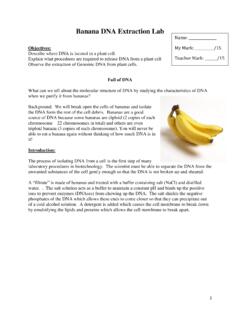Transcription of Skin 1: the structure and functions of the skin - EMAP
1 Copyright EMAP Publishing 2019 This article is not for distributionexcept for journal club use30 Nursing Times [online] December 2019 / Vol 115 Issue 12 Skin diseases affect 20-33% of the UK population at any one time (All Parliamentary Group on Skin, 1997) and surveys suggest around 54% of the UK population will experience a skin condition in a given year (Schofield et al, 2009). Nurses will observe the skin daily while caring for patients and it is impor-tant they understand it so they can recog-nise problems when they arise. The skin and its appendages (nails, hair and certain glands) form the largest organ in the human body, with a surface area of 2m2 (Hughes, 2001).
2 The skin comprises 15% of the total adult body weight; its thickness ranges from < at its thin-nest part (eyelids) to at its thickest part (palms of the hands and soles of the feet) (Kolarsick et al, 2011). This article reviews its structure and of the skinThe skin is divided into several layers, as shown in Fig 1. The epidermis is composed mainly of keratinocytes. Beneath the epi-dermis is the basement membrane (also known as the dermo-epidermal junction); this narrow, multilayered structure anchors the epidermis to the dermis. The layer below the dermis, the hypodermis, consists largely of fat.
3 These structures are described epidermis is the outer layer of the skin, defined as a stratified squamous epithe-lium, primarily comprising keratinocytes in progressive stages of differentiation (Amirlak and Shahabi, 2017). Keratinocytes produce the protein keratin and are the major building blocks (cells) of the epi-dermis. As the epidermis is avascular (con-tains no blood vessels), it is entirely dependent on the underlying dermis for nutrient delivery and waste disposal through the basement membrane . The prime function of the epidermis is to act as a physical and biological barrier to the external environment, preventing penetration by irritants and allergens.
4 At the same time, it prevents the loss of water and maintains internal homeostasis (Gawkrodger, 2007; Cork, 1997). The epi-dermis is composed of layers; most body parts have four layers, but those with the thickest skin have five. The layers are:l Stratum corneum (horny layer);l Stratum lucidum (only found in thick skin that is, the palms of the hands, the soles of the feet and the digits);Keywords Skin/Skin function/Skin assessment/Epidermis/Dermis This article has been double-blind peer reviewedKey points The skin is the largest organ in the human bodyApproximately half of the UK population will experience a skin condition in any given yearNurses observe patients skin daily, so need to be able to identify problems when they ariseKey functions of the skin include protection, regulation of body temperature, and sensationHow others respond to people who have skin conditions is an important consideration for nurses Skin 1.
5 The structure and functions of the skinAuthor Sandra Lawton, Queen s Nurse and nurse consultant and clinical lead dermatology, The Rotherham NHS Foundation Skin diseases affect 20-33% of the population at any one time, and around 54% of the UK population will experience a skin condition in a given year. Nurses observe the skin of their patients daily and it is important they understand the skin so they can recognise problems when they arise. This article, the first in a two-part series on the skin, looks at its structure and Lawton S (2019) Skin 1: the structure and functions of the skin. Nursing Times [online]; 115, 12, this How the skin is structuredl functions of the skinl Specialised cells and structuresClinical PracticeSystems of lifeSkin Copyright EMAP Publishing 2019 This article is not for distributionexcept for journal club use31 Nursing Times [online] December 2019 / Vol 115 Issue 12 , microfilaments and microtubules (keratinisation).
6 The outer layer of the epi-dermis, the stratum corneum, is com-posed of layers of flattened dead cells (cor-neocytes) that have lost their nucleus. These cells are then shed from the skin (desquamation); this complete process takes approximately 28 days (Fig 3). Between these corneocytes there is a com-plex mixture of lipids and proteins (Cork, 1997); these intercellular lipids are broken down by enzymes from keratinocytes to pro-duce a lipid mixture of ceramides (phospho-lipids), fatty acids and cholesterol. These l Stratum granulosum (granular layer);l Stratum spinosum (prickle cell layer);l Stratum basale (germinative layer).The epidermis also contains other cell structures.
7 Keratinocytes make up around 95% of the epidermal cell population the others being melanocytes, Langerhans cells and Merkel cells (White and Butcher, 2005). Keratinocytes. Keratinocytes are formed by division in the stratum basale. As they move up through the stratum spinosum and stratum granulosum, they differen-tiate to form a rigid internal structure of Fig 2. Layers of the skin molecules are arranged in a highly organised fashion, fusing with each other and the cor-neocytes to form the skin s lipid barrier against water loss and penetration by aller-gens and irritants (Holden et al, 2002). The stratum corneum can be visualised as a brick wall, with the corneocytes forming the bricks and lamellar lipids forming the mortar.
8 As corneocytes con-tain a water-retaining substance a nat-ural moisturising factor they attract and hold water. The high water content of the corneocytes causes them to swell, keeping the stratum corneum pliable and elastic, and preventing the formation of fissures and cracks (Holden et al, 2002; Cork, 1997). This is an important consideration when applying topical medications to the skin. These are absorbed through the epidermal barrier into the underlying tissues and structures (percutaneous absorption) and transferred to the systemic circulation. The stratum corneum regulates the amount and rate of percutaneous absorp-tion (Rudy and Parham-Vetter, 2003).
9 One of the most important factors affecting this is skin hydration and environmental humidity. In healthy skin with normal hydration, medication can only penetrate the stratum corneum by passing through the tight, relatively dry, lipid barrier between cells. When skin hydration is increased or the normal skin barrier is impaired as a result of skin disease, excoriations, erosions, fissuring or prema-turity, percutaneous absorption will be increased (Rudy and Parham-Vetter, 2003).Melanocytes. Melanocytes are found in the stratum basale and are scattered among the keratinocytes along the basement mem-brane at a ratio of one melanocyte to 10 basal cells.
10 They produce the pigment mel-anin, manufactured from tyrosine, which is an amino acid, packaged into cellular vesicles called melanosomes, and trans-ported and delivered into the cytoplasm of the keratinocytes (Graham-Brown and Bourke, 2006). The main function of mel-anin is to absorb ultraviolet (UV) radiation to protect us from its harmful effects. Skin colour is determined not by the number of melanocytes, but by the number and size of the melanosomes (Gawkrodger, 2007). It is influenced by sev-eral pigments, including melanin, caro-tene and haemoglobin. Melanin is trans-ferred into the keratinocytes via a melanosome; the colour of the skin there-fore depends of the amount of melanin produced by melanocytes in the stratum basale and taken up by keratinocytes.

















